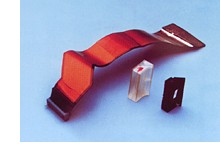|
Texas Instruments DSEG
|
The ability to manufacture "flight-qualified" hardware quickly and flawlessly is critical
to major defense contracts. Texas Instruments has come to rely on stereolithography to meet
shorter program lead times and generate "flight-ready" parts with total confidence.
|

|
The Challenge
With only one week to spare, the SL group at Texas Instruments Defense Systems and Electronics
Group (TI DSEG) was faced with the task of building a complex cable holding device for a new
weapons system designed to position and hold a flex cable for a pretension type atmosphere.
Getting the right tension on the cable was critical to prevent severing during vibration tests.
The task was made more difficult by certain operational requirements: the device had to he
cantilevered out to keep from breaking itself; it had to deliver flawless system performance
over an 8,000 miles operational range, plus withstand high pressure air speeds of Mach 1.2.
Once the mission was complete, the device had to easily disconnect from its airborne vehicle.
One option was to build the cabling device via injection molding dies. But a 20-30 week lead
time was necessary -- and that was out of the question for this mission. With little
hesitation, the TI DSEG team reached the conclusion that the only acceptable solution was to
create the device through stereolithography for rapid prototyping.
The Results
For hardware to be approved as "flight-qualified," it must be able to withstand the radical
shifts in temperature and vibration produced by an aircraft on take-off, landing, or at
altitudes of 30,000 feet or more. Once part performance meets these stringent flight standards,
the hardware becomes "flight ready." As evidenced by the cable holding device, SL enabled
TI DSEG to achieve its delicate balance between time, cost, quality, and performance with
some of these benefits:
- Deliver a performance-critical product on schedule
- Accelerate product cycle-finished product in one week versus 6 months
- Realize a sizable cost savings by eliminating need for injection molding
dies (single cavity mold can cost $7,500; dies can easily require double or
quadruple cavities)
- Eliminate the need for tooling and its costly investment
- Win the loyalty of a highly satisfied internal customer who did not expect TI could
react to produce, assemble, and ship a perfect part in only one week
The Process
According to the design specification, the cable holding device measured 4" x 1.5" x 5/8".
Two iterations on TI DSEG's SLA 250 provided ample opportunity for part visualization and
verification. The completed SLA parts clearly revealed to the TI DSEG team what they couldn't
see in the CAD file, but needed to know. The actual SLA part exposed an over-extension of the
angle of the cable into the electronic tray holder of 22.5 degrees. During operation of a
typical weapons system, the force of the harmonics or fluttering occurs, putting the part at
serious risk to shear itself under the motion of heavy vibration.
With this knowledge in band, the design for the cable holding device was readily optimized.
The team was able to alter the angle slightly and, in the process, discovered that the part
performed best at 24 degrees. The benefit of a multiple iteration helped the SL team to
optimize what they didn't know at the initial design stage to avert a potential design error.
The Tools
- Pro/ENGINEER CAD software with Bridgeworks to produce the supports
- SLA 250 with Cibatool SL 5149 photopolymer
Company Profile
Texas Instruments, based in Dallas, Texas, is a $7.5 billion high technology market leader in
semiconductors, consumer products, materials and controls, information technology and defense
electronics. The company operates sales and manufacturing operations in more than 30 countries.
The Defense Systems and Electronics Group was selected by the U.S. Department of Commerce to
receive a 1992 Malcolm Baldridge National Quality Award in the manufacturing category -- the
first time a defense contractor has been so honored.
|



